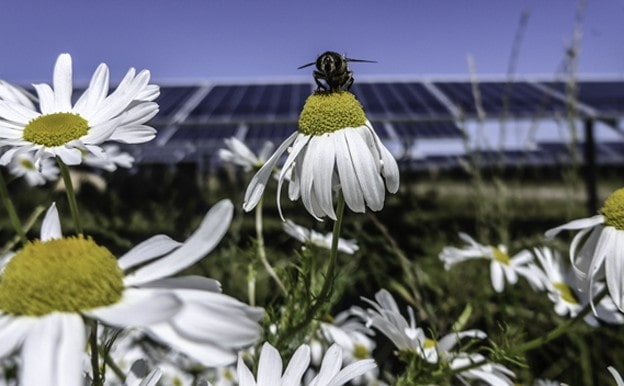Overview
Pollinators, such as honeybees and butterflies, are the unsung heroes of agriculture. However, their populations have been collapsing in recent years, creating a crisis for farmers who depend on them. Solar developers have started creating habitat sanctuaries to help reverse this trend.
Pollinators – Impacts and Risks
As they travel from flower to flower, bees and other insects carry pollen with them from one plant to the next. This is crucial for flowering plants to reproduce. As Fox News recently reported, honey bees alone can pollinate over 75% of flowering plants and crops. This substantially boosts the crop yields of everything from apples to soybeans. Overall, pollinators contribute over $24 billion to the US economy.
The enormous contributions of pollinators make their recent population crash especially troubling. There was a 44% decrease in bee colonies between 2015 and 2016, and it is estimated that over half of the bee species are in decline. Furthermore, almost a quarter are at risk of extinction.
Solar Developers Stepping In
Some solar developers have found a way to help out their local pollinators. In a typical solar farm, the ground under and around the panels is planted with grass to control soil erosion. By replacing the grass with native wildflowers, solar farms can be turned into an ideal habitat for bees, butterflies, and many other kinds of birds and insects.
In addition to supporting pollinators, native wildflowers have several other advantages over grasses for use in solar development. Because they grow naturally in the area, they tend to be hardier and require less maintenance. Developers can also select species that are naturally short and don’t require mowing. Wildflowers have root systems that extend down several feet, as opposed to several inches for grass, which makes them better at controlling stormwater runoff.
Given that each solar farm can cover hundreds of acres, this habitat can really add up. In Minnesota, which is leading the way for this type of development, there is now 2,300 acres of pollinator habitat on solar farms that would otherwise have been planted with grass.
Legislative Support
Minnesota is also leading the way for legislative efforts to promote pollinator habitat on solar farms. In 2016 the legislature passed the Pollinator Friendly Solar Act, which establishes a set of voluntary criteria to designate projects as pollinator sanctuaries. Projects are scored on 7 criteria, dealing with the percentage of the area that is covered with wildflowers, the diversity of wildflower species on site and the use of pesticides. The Maryland Senate is currently considering similar legislation.
Pollinator habitat enjoys a broad coalition of support from the solar industry, agricultural groups, and environmental activists. It is a cost-neutral way to conserve habitat for vulnerable species while helping neighboring farms through increased crop yields. It also allows farms to be developed while maintaining the character of rural communities. This is truly a win-win for all parties involved, and we look forward to seeing more habitat development in the future.


Leave A Comment